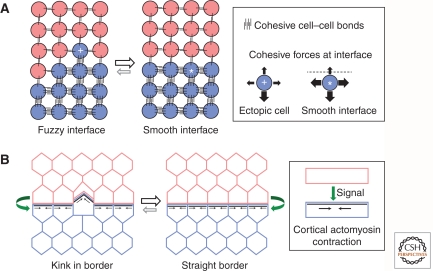Figure 2.
Cell adhesion and cortical tension. (A) One mechanism underlying cell segregation is mediated by differential adhesion of the two distinct cell populations. The differential adhesion hypothesis proposes that segregation is driven by the aggregate achieving the lowest free energy in which there is maximal contact between cells with the higher mutual affinity. At the interface of the two populations, interfacial tension occurs because the more adhesive cells (blue) will experience stronger cohesive forces from “like” cells than from “unlike” cells (red). The cohesive forces experienced by an ectopic cell (+) or by a cell at a smooth interface (*) are illustrated. At a fuzzy interface there is a net decrease in cohesive bonds and increase in free energy compared with a smooth interface. (B) Another mechanism that underlies boundary sharpening and maintenance is mediated by cortical tension. Signaling from one cell population (red) induces assembly and contraction of cell-surface-associated actomyosin in the adjacent cells (blue). This cortical tension sharpens the borders and restrains movement of cells across the interface.

